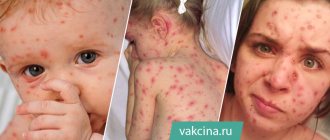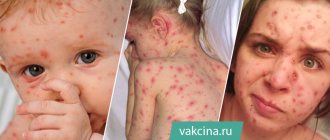- What is chickenpox?
- What is an allergy?
- Chickenpox or allergies?
Repeatedly, young parents asked the pediatrician the same question - how to distinguish chickenpox from allergies, if the external signs of these diseases are similar to each other.
Skin rashes almost always appear due to allergic diseases. But an infectious disease such as chickenpox is also characterized by the appearance of a rash on the skin. To find out what kind of pathology we are talking about, you need to have a general idea of each.
Key Similarities Between Chickenpox and Allergies
Many people often confuse an allergic rash with chickenpox. This is not surprising, because chickenpox in the initial stages is very similar to an allergic rash. Allergic blisters are characterized as reddish and raised spots on the skin that can quickly appear in different parts of the body. The level of itching with an allergic rash often coincides with the rash with chickenpox. Among the first symptoms of chickenpox can be found:
- chills;
- elevated temperature;
- headache;
- rash on the body.
Basic allergy symptoms include:
- rash;
- itching of the skin;
- runny nose;
- itching in the eye area.
With both chickenpox and allergies, the rash initially appears on the upper torso, face, and flexures of the joints of the arms and legs.
In the photo below we depict the first signs of chickenpox and allergies in a child:
Table: First signs of chickenpox and allergies in a child
Care and treatment at home
Children with chickenpox can usually be cared for and treated at home. Because chickenpox is a virus, it cannot be treated with antibiotics. Treatment is to control the itching of the rash and other symptoms associated with viral illnesses. There are many medications and creams that can relieve itchy skin.
It is important to ensure that your child drinks enough fluids and does not become dehydrated. Give your child liquids in various forms: clean water, jellies, sorbets, soups and other liquids.
Children with chickenpox may have a fever and feel tired and irritable. Important to know: Aspirin is contraindicated for a child with chickenpox. Children with very severe infections or serious illnesses may receive additional antiviral medications as prescribed by their doctor.
Main differences between chickenpox and allergies
Let's take a closer look at the main differences between chickenpox and allergies. In order to determine whether a child has chickenpox or an allergy, you need to pay attention to some aspects:
Causal relationship
: whether skin rashes occurred after eating a new product, using a new detergent, or contact with an animal. Chickenpox can only occur in one case - contact with the chickenpox virus.
General appearance of the rash
: pay attention to the color of the rash and the skin around it, whether the rash disappears when pressed. An allergy rash looks like a nettle burn. The chickenpox rash is cyclical, progressing from pink papules to fluid-filled vesicles, which dry out and crust over time.
Localization of the occurrence of rashes
: Pay attention to the presence of rashes on the mucous membranes and how painful they are. An allergic rash occurs mainly on the skin, while rashes from chickenpox can occur on the mucous membranes.
Presence of itching
: Pay attention to the level of itching, temperature status, whether there is a runny nose, coughing, sneezing, or sore throat. Chickenpox is most often accompanied by a general condition similar to a viral infection. An allergy may have only one symptom that occurs in special cases.
Contagiousness degree
: Allergies are not contagious, unlike chickenpox.
Body temperature:
pay attention to the presence of elevated temperature.
With allergies, there is usually no increase in temperature. As a hyperthermic syndrome, chickenpox is accompanied by an increase in body temperature. Treatment:
allergies are quite easily treated by eliminating the allergen and taking antihistamines. Chickenpox, in turn, is treated only by eliminating various symptoms, antiviral, antipyretic, and anti-itching agents. In the photo we depicted what the rash looks like with chickenpox and allergies:
Photo: allergies or chicken pox
Clinical picture of chickenpox
Having familiarized yourself with the clinical pictures, you can quickly and easily identify allergies and chickenpox. However, no one other than a doctor can prescribe treatment. The chickenpox virus remains in the human nervous system forever. With a weakened immune system and improper body care, the virus can develop into herpes zoster. The main symptoms of chickenpox are:
- an itchy rash that develops into a vesicular rash;
- the rash is initially observed on the upper torso and face;
- rashes are accompanied by fever and general weakness;
- a rash occurs on the scalp;
- the rash in appearance looks like blisters rising above the reddened surface of the skin, filled with clear liquid;
- After a few days, these watery blisters begin to dry out.
Many people are interested in how long it takes for chickenpox and allergies to appear. The answer is quite simple, allergies manifest themselves quite quickly. The reaction may occur within an hour. Chickenpox is a longer lasting disease. Let's start with the fact that before its external manifestation (2-3 days), the child is already infectious and remains so until the vesicles begin to dry out.
How to recognize a flea bite
As a rule, flea bites are located in a continuous path, but not always - there may be chaotically located foci. The bites itch unbearably, sometimes even swell and are characterized by severe pain. But that comes later, and in the process they secrete a special anesthetic secretion. Typically, fleas bite those places where the skin is thinnest - the tops of the feet, heels, ankles and lower legs.
The bite site immediately turns red and begins to itch very much. After a couple of days, the point enlarges and soon becomes a small blister, in the center of which there may be a bloody ulcer. Experts do not recommend scratching the problem area, even with severe itching. The best solution is to relieve pain using special means.
Failed to avoid attack - what to do
Most often, improvised means are used to treat flea bites. As mentioned above, bite sites should not be scratched. First, it is better to wash them with warm running water and antiseptic soap, and then lubricate them with Calamine lotion. But if you don’t have such a remedy in your home medicine cabinet, then you can use alternative homemade medications.
- In a glass or mug, dilute sodium bicarbonate with a small amount of water until a paste-like mixture forms. Apply the prepared mixture to the affected area of the body for 20 minutes. This remedy will help to calm the itching and burning a little.
- In a glass container, mix water and apple cider vinegar in a 2:1 ratio. Place in the refrigerator for 10-15 minutes. Dip a thin strip of natural fabric or gauze into the cooled mixture and apply to the bite site for 20 minutes.
- Boil 350 ml of water, add a few lemon skins to it, and boil for 5 minutes. Cool. Next, moisten a small strip of clean gauze or bandage in the infused liquid and wrap it around the bitten area. After 20-25 minutes, you will feel the swelling subsiding slightly and the itching subsiding.
- Another effective method: heat a small amount of honey, add a couple of tablespoons of lemon juice to it. Let the mixture cool. Then put it in a gauze bandage and apply it to the bite site for 30 minutes.
Important! If we are talking about multiple flea bites, then the compositions indicated in paragraphs 2, 3 and 4 do not simply serve to impregnate the fabric with which the affected areas are wiped. Compresses are made from the decoctions at night, which significantly improves the situation and relieves unpleasant symptoms.
Clinical picture of allergies
Above we looked at the clinical picture of chickenpox, in this block we will describe in detail how to distinguish allergies from chickenpox. Allergies arise as a painful reaction of the immune system to an irritant. That is, itching, rash and swelling are the body’s response to contact with an allergen. In addition to these symptoms, your child may experience sneezing, coughing, and runny nose. In some cases, the mucous membranes of the eyes may become inflamed.
The first stage of allergy is diathesis, which is characterized by the appearance of a rash and itching on the buttocks and cheeks. If you do not start treating diathesis, allergies can develop into eczema. At this stage, itchy blisters with liquid appear.
If eczema is not treated promptly, the allergic reaction can develop into the third stage - atopic dermatitis. Dermatitis may subside in adolescence; it rarely remains active in adults.
The mother's diet during pregnancy or breastfeeding does not greatly affect the child's sensitivity to allergens. Medical experts note that allergies occur more often in children who are on artificial nutrition, since cow protein is considered a strong irritant. Allergies can also be one of the complications after chickenpox in children, since the body is still weakened and is not able to actively protect itself from external irritants. When determining the allergen, only a doctor can prescribe treatment for the child. To eliminate an allergic reaction, antihistamines are most often prescribed.
How to distinguish chickenpox from allergies?
The symptoms of chickenpox or allergies are quite similar. However, they have their own characteristics. Below we have listed the signs by which these two diseases can be distinguished.
What is the difference between chickenpox and allergies?
Placement of the rash.
With allergies and chickenpox, a rash can occur on any area of the skin. However, papules on the mucous membranes are a sign of chickenpox. Allergies usually irritate the skin and most often occur on the elbows, knees, hands and face. Chickenpox can affect the entire body at once.
Table: Difference between chickenpox and allergies
Nature of rashes
. The chickenpox rash develops cyclically: first a papule (bump) appears, after a few days the papule fills with liquid and then becomes covered with a crust. Vesicles on the body appear in waves and do not merge with each other.
Allergy rashes can cluster and form plaques that are itchy and flaky.
Reaction to antihistamines.
Taking antihistamines for chickenpox cannot prevent the development of chickenpox. Being a viral disease, chickenpox moves on its own and anti-allergenic drugs cannot stop the development of vesicles.
Unlike chickenpox, allergies can be treated with medication. Significant relief can be experienced by eliminating the allergen. If the skin rash is an allergic reaction to some product, then antihistamines will be able to delay or eliminate the development of the allergy.
Characteristic symptoms
. The main symptoms of chickenpox include high fever and cold-like symptoms. The most common symptoms of allergies are rash and itching. Sometimes the symptoms can be mixed and in addition to the above symptoms, a person may experience a runny nose, sneezing, and coughing. These features are not accompanied by high fever (as can occur with chickenpox).
Prerequisites for the body's reaction
. Chickenpox has only one cause: the varicella zoster virus. Therefore, if you or your child have not yet had chickenpox and come into contact with someone who is sick, you can catch this virus. An allergic reaction, in turn, can occur after consuming or overusing a new product, chocolate, citrus fruits and other allergens. After contact with animals, dust and other external irritants, you may also experience allergies.
If you have any doubts about the diagnosis, you can always undergo laboratory diagnostics. This test determines the presence of antibodies to the Varicella-Zoster virus. However, a doctor can make a final diagnosis.
Can there be an allergy due to chickenpox?
An allergic reaction can occur during chickenpox. However, this is quite a rare occurrence. A rash may appear as a reaction to some irritant: food product, wool, flowers or dust. To alleviate the child’s condition, consult a doctor who will help get rid of one ailment in order to avoid complications during chickenpox.
In the photo below we depict what the initial stage of chickenpox with allergies looks like:
Photo: The onset of chickenpox in a child and allergies
When to see a doctor?
Parents should call a doctor if:
- Child's age is less than 6 months
- Inflamed, red areas of skin appear around the blisters, which may indicate a secondary bacterial infection.
- Children become increasingly ill, they become drowsy, the temperature rises above 38C, and children drink little liquid or refuse to drink
- If your child feels unwell with a high fever and a skin rash that looks like small, bright red or purple spots or bruises that don't fade when you press on them, this may be a sign of meningococcal infection.
Chickenpox is not dangerous when parents know what to do, vaccinate their child in a timely manner, and quickly decide to call a doctor. After an illness, a fairly stable immunity develops, and the likelihood of recurrent illness is minimal.
In our medical center, you can consult with an immunoprophylaxis specialist or a pediatrician about when you should vaccinate your child or call a doctor at home if your baby suddenly gets sick.
Call a doctor at home Make an appointment with a doctor or call +7 (812) 331-17-74
Types of rashes and localization
If you are in doubt what type of rash you have on your skin and you don’t know how to determine whether you have chickenpox or an allergy, consult a doctor who will help determine what kind of illness you have. The rash caused by chickenpox and allergies have certain differences. Let's look at them in more detail:
Chickenpox rash
It is usually not difficult for parents to recognize chickenpox in a child. Chickenpox rashes appear on the scalp or abdomen and gradually spread throughout the body.
Chickenpox pockmarks appear in waves. During each wave, a child or an adult experiences an increase in temperature. Rashes of all three stages can be observed on the body.
It is strictly forbidden to scratch pockmarks with chickenpox, because this increases the risk of infection and can leave scars on the skin. Antihistamines cannot have a visible effect on chickenpox rash, but they can dull the itching a little.
Allergy rash
Allergy rashes are local in nature. They are usually grouped in a certain area and tightly.
Allergic rashes look the same and occur, mainly, simultaneously forming spots with redness.
With an allergic reaction, the rashes look the same and all appear at the same time.
If you take antihistamines and follow a hypoallergenic diet (if necessary), the rashes will go away and the skin will recover after them.
Table: Difference between chickenpox rash and allergy rash
What do bedbug bites look like?
Bedbug bites are also arranged in a “straight path”. Bedbug saliva also contains an anesthetic substance, and therefore a person will not be able to “catch” the insect during a bite. And, for example, when you wake up in the middle of the night, you will not immediately find a bloodsucker on you or on your bed. Burning and itching appear a few minutes later. Although, if you are bitten by young pests that have not reached puberty, the symptoms may appear instantly, since their saliva does not yet have an anesthetic effect.
It's hard to believe, but you may not feel this way for a while
The bite sites of these pests have their own characteristic signature: a small red spot on which 4-5 bites are located. Often such reddened “islands” are arranged in one line. The bites quickly swell, become inflamed and take on a reddish-pink color. A small blood spot can be seen in the center of the swollen lump.
All areas of the body exposed during sleep can be susceptible to bedbug attacks - the face, neck, shoulders, arms, even legs. Like flea bites, bedbug bites should also not be scratched, as you yourself, without knowing it, can spread infection from scratched wounds throughout the body.
Important! Bedbugs are nocturnal insects. They go out hunting only in the dark, and during the day they hide in secluded, hard-to-reach places. This is what explains the anxiety that people experience during night sleep.
The 2 easiest ways to treat bedbug bites
If you do not start treating the affected skin areas in time, you risk getting even more irritated skin, including severe allergic reactions or spreading infection throughout the body. Therefore, it is important to be able to calm the itching at least a little and reduce pain instantly.
Method No. 1
The first step is to thoroughly disinfect the sites of bedbug attacks. Soak a bandage or cotton swab in ethyl alcohol or benzene peroxide and wipe the bites. Afterwards, apply a small amount of anti-itch cream, give it a few minutes to completely absorb into the skin. It will feel better immediately.
Method No. 2
Doctors also recommend using antihistamines, which can be bought at any pharmacy kiosk. Taking the tablets can be combined with the following procedure: apply a piece of ice to the bite site for 20-30 minutes. Afterwards, for the same period of time, the cold compress should be replaced with a hot one. Repeat the procedure 3-5 times a day. A set of therapeutic measures will help to quickly relieve swelling, reduce pain and itching.
Special types of chickenpox and allergies
An allergic reaction occurs as a response to a specific allergen. The body's reaction to an allergen can manifest itself in different ways. In some cases, the allergic rash is similar to chickenpox, but along with it there are a number of symptoms that make it clear that it is not chickenpox. Let's take a closer look at how allergies can manifest themselves.
Among the most common types of allergies
we can name cases when:
The rash may occur in areas of large folds. It can appear on the neck, abdomen, elbows, knees, and groin. The rash is accompanied by itching, and the skin thickens.
Hives are also a manifestation of allergies. Urticaria is characterized by the appearance of small blisters, headache and symptoms of intoxication of the body. Symptoms of an allergic reaction occur quite quickly (within an hour after contact).
Eczema is often accompanied by local weeping papules, which can occur after severe stress, anxiety and as a result of poor nutrition. Eczema is also accompanied by mild itching, which gradually intensifies, and the appearance of vesicles, which intensify after scratching.
A toxic form of allergic reaction occurs after excessive contact with household chemicals. In advanced forms of toxic dermatitis, tissue necrosis may occur.
Types of chickenpox
Chickenpox occurs in two forms: typical and atypical. A typical one usually passes without complications and special losses.
Atypical comes in several forms:
The hemorrhagic form is accompanied by hemorrhage into the vesicles.
The pustular form occurs when a bacterial agent enters the papules.
The gangrenous form occurs when the immune system is weakened and can develop into sepsis.
The generalized (visceral) form of chickenpox increases the risk of death, as it often occurs in patients with immunodeficiency.
The vestigial form is considered one of the easiest forms. It often affects children who received immunoglobulin during the incubation period.
The severity of chickenpox depends on the person's health and the level of intoxication.
Bedbug and flea bites: what health consequences can they have?
Most often, the human body reacts to enzymes contained in the saliva of these pests. Inflammatory skin diseases, various ulcers, and eczema may appear. A severe allergy develops.
Torment and pain - you should not allow such conditions
Flea bites can cause the development of pulicosis, a skin disease in which a person’s lymph nodes increase in size, body temperature rises, and the bites begin to fester. In addition, painful ulcers form in the mouth and on the walls of the throat. A person suffers from headaches and insomnia.
Chickenpox or allergy: final verdict or point in diagnosis
When the first symptoms occur, consult a doctor who can make the correct diagnosis. During diagnosis, the doctor pays attention to the general condition of the patient and studies the frequency of symptoms when exposed to allergens.
An allergic reaction occurs with repeated allergy tests. If a patient is allergic to a certain component, the reaction occurs almost instantly (within a few minutes to half an hour). Allergies also cause a typical skin rash and swelling may occur. It should be noted again that increased body temperature is not observed.
When diagnosing chickenpox, no allergic reactions are observed. The development of the disease has a pronounced phasing, for example the development of papules. Being a viral disease, chickenpox is contagious and is most often observed in children.
No less effective is laboratory diagnostics to determine the virus.
Diagnostic test
This test helps determine if you are infected with the chickenpox virus (VZV). When you first become infected with VZV, the virus remains in your nervous system but is dormant (inactive). VZV may later become active and cause shingles.
Shingles is a disease that only affects people who have previously had chickenpox. It is characterized by a painful and burning rash that may remain in one part of the body or spread further.
Allergies, unlike chickenpox, do not cause such serious complications in the body.
Chickenpox or allergies: treatment
Although treatment for chickenpox includes taking antihistamines, they are not the mainstay of treatment. With chickenpox, it is first of all important to eliminate the symptoms: fever, itching and other complications. Therefore, treatment is often carried out using local remedies or herbal baths. Allergy tablets and drops are quite acceptable. Read more about the treatment of allergies and chickenpox in our articles. After vaccination, a person may develop a rash. If this happens, the chickenpox vaccine virus can spread to an unprotected person. Anyone who develops a rash should stay away from people with weakened immune systems and infants until the rash clears up. Talk to your doctor to find out the cause of the rash.
*** We have already shared with you information about the differences between chickenpox and allergies. And it’s great that you can navigate on your own. However, in any case, you will need to see a doctor who will draw up a detailed treatment plan. Regardless of whether it is an allergy or chickenpox, do not self-medicate, as this can lead to disastrous results.
Share with friends
Rate this article









